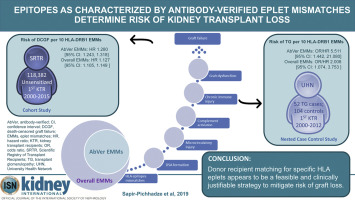当前位置:
X-MOL 学术
›
Kidney Int.
›
论文详情
Our official English website, www.x-mol.net, welcomes your
feedback! (Note: you will need to create a separate account there.)
Epitopes as characterized by antibody-verified eplet mismatches determine risk of kidney transplant loss.
Kidney International ( IF 14.8 ) Pub Date : 2019-11-12 , DOI: 10.1016/j.kint.2019.10.028 Ruth Sapir-Pichhadze 1 , Xun Zhang 2 , Abdelhakim Ferradji 3 , Abeer Madbouly 4 , Kathryn J Tinckam 5 , Howard M Gebel 6 , Daniel Blum 7 , Marilyn Marrari 8 , S Joseph Kim 9 , Stephanie Fingerson 4 , Pradeep Bashyal 4 , Héloïse Cardinal 10 , Bethany J Foster 11
Kidney International ( IF 14.8 ) Pub Date : 2019-11-12 , DOI: 10.1016/j.kint.2019.10.028 Ruth Sapir-Pichhadze 1 , Xun Zhang 2 , Abdelhakim Ferradji 3 , Abeer Madbouly 4 , Kathryn J Tinckam 5 , Howard M Gebel 6 , Daniel Blum 7 , Marilyn Marrari 8 , S Joseph Kim 9 , Stephanie Fingerson 4 , Pradeep Bashyal 4 , Héloïse Cardinal 10 , Bethany J Foster 11
Affiliation

|
To optimize strategies that mitigate the risk of graft loss associated with HLA incompatibility, we evaluated whether sequence defined HLA targets (eplets) that result in donor-specific antibodies are associated with transplant outcomes. To define this, we fit multivariable Cox proportional hazard models in a cohort of 118 382 United States first kidney transplant recipients to assess risk of death-censored graft failure by increments of ten antibody-verified eplet mismatches. To verify robustness of our findings, we conducted sensitivity analysis in this United States cohort and assessed the role of antibody-verified eplet mismatches as autonomous predictors of transplant glomerulopathy in an independent Canadian cohort. Antibody-verified eplet mismatches were found to be independent predictors of death-censored graft failure with hazard ratios of 1.231 [95% confidence interval 1.195, 1. 268], 1.268 [1.231, 1.305] and 1.411 [1.331, 1.495] for Class I (HLA-A, B, and C), -DRB1 and -DQB1 loci, respectively. To address linkage disequilibrium between HLA-DRB1 and -DQB1, we fit models in a subcohort without HLA-DQB1 eplet mismatches and found hazard ratios for death-censored graft failure of 1.384 [1.293, 1.480] for each additional antibody-verified HLA-DRB1 eplet mismatch. In a subcohort without HLA-DRB1 mismatches, the hazard ratio was 1.384 [1.072, 1.791] for each additional HLA-DQB1 mismatch. In the Canadian cohort, antibody-verified eplet mismatches were independent predictors of transplant glomerulopathy with hazard ratios of 5.511 [1.442, 21.080] for HLA-DRB1 and 3.640 [1.574, 8.416] for -DRB1/3/4/5. Thus, donor-recipient matching for specific HLA eplets appears to be a feasible and clinically justifiable strategy to mitigate risk of graft loss.
中文翻译:

以抗体验证的表位不匹配为特征的抗原决定簇决定了肾移植丢失的风险。
为了优化减轻与HLA不相容性相关的移植物丢失风险的策略,我们评估了导致供体特异性抗体的序列定义的HLA靶标(小片段)是否与移植结果相关。为了定义这一点,我们在118 382名美国第一位肾脏移植受者队列中拟合了多变量Cox比例风险模型,以通过增加十个经过抗体验证的eplet不匹配来评估死亡检查的移植失败的风险。为了验证我们研究结果的稳健性,我们在该美国队列中进行了敏感性分析,并评估了一个独立于加拿大队列的抗体验证的eplet错配作为移植肾小球病变的自主预测因子的作用。发现抗体验证的小球错配是死亡检查的移植物衰竭的独立预测因素,I类危险比为1.231 [95%置信区间1.195,1. 268],1.268 [1.231,1.305]和1.411 [1.331,1.495] (HLA-A,B和C),-DRB1和-DQB1位点。为了解决HLA-DRB1和-DQB1之间的连锁不平衡问题,我们将模型拟合到没有HLA-DQB1 eplet错配的亚人群中,并且发现每增加一个经过抗体验证的HLA-DRB1,死亡检查的移植物衰竭的危险比为1.384 [1.293,1.480] eplet不匹配。在没有HLA-DRB1失配的亚人群中,每增加一个HLA-DQB1失配,危险比为1.384 [1.072,1.791]。在加拿大队列中,经过抗体验证的eplet错配是移植肾小球病的独立预测因子,危险比为5.511 [1.442,21。对于HLA-DRB1为080],对于-DRB1 / 3/4/5为3.640 [1.574,8.416]。因此,特定HLA eplets的供体-受体匹配似乎是减轻移植物丢失风险的可行且临床上合理的策略。
更新日期:2019-11-13
中文翻译:

以抗体验证的表位不匹配为特征的抗原决定簇决定了肾移植丢失的风险。
为了优化减轻与HLA不相容性相关的移植物丢失风险的策略,我们评估了导致供体特异性抗体的序列定义的HLA靶标(小片段)是否与移植结果相关。为了定义这一点,我们在118 382名美国第一位肾脏移植受者队列中拟合了多变量Cox比例风险模型,以通过增加十个经过抗体验证的eplet不匹配来评估死亡检查的移植失败的风险。为了验证我们研究结果的稳健性,我们在该美国队列中进行了敏感性分析,并评估了一个独立于加拿大队列的抗体验证的eplet错配作为移植肾小球病变的自主预测因子的作用。发现抗体验证的小球错配是死亡检查的移植物衰竭的独立预测因素,I类危险比为1.231 [95%置信区间1.195,1. 268],1.268 [1.231,1.305]和1.411 [1.331,1.495] (HLA-A,B和C),-DRB1和-DQB1位点。为了解决HLA-DRB1和-DQB1之间的连锁不平衡问题,我们将模型拟合到没有HLA-DQB1 eplet错配的亚人群中,并且发现每增加一个经过抗体验证的HLA-DRB1,死亡检查的移植物衰竭的危险比为1.384 [1.293,1.480] eplet不匹配。在没有HLA-DRB1失配的亚人群中,每增加一个HLA-DQB1失配,危险比为1.384 [1.072,1.791]。在加拿大队列中,经过抗体验证的eplet错配是移植肾小球病的独立预测因子,危险比为5.511 [1.442,21。对于HLA-DRB1为080],对于-DRB1 / 3/4/5为3.640 [1.574,8.416]。因此,特定HLA eplets的供体-受体匹配似乎是减轻移植物丢失风险的可行且临床上合理的策略。









































 京公网安备 11010802027423号
京公网安备 11010802027423号